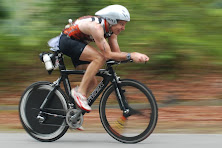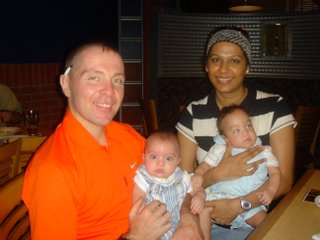 Check this phenomenon out - mass rides through cities on the last Friday of every month - usually bringing traffic to a standstill in a mass demonstration of pedal power - sounds wicked! What about something like this in Kuala Lumpur?
Check this phenomenon out - mass rides through cities on the last Friday of every month - usually bringing traffic to a standstill in a mass demonstration of pedal power - sounds wicked! What about something like this in Kuala Lumpur?I think the government here would know how to deal with it - you wouldn't see any of us for two years as we'd be whisked away under the ISA (Internal Security Act) and that would be that. One can dream though. The web site is http://critical-mass.info/origin.html
This is what Wikipedia has to say about it: -
"Critical Mass is an event typically held on the last Friday of every month in cities around the world where bicyclists and, less frequently, unicyclists, skateboarders, inline skaters, roller skaters and other self-propelled commuters take to the streets en masse. While the ride was originally founded with the idea of drawing attention to how unfriendly the city was to bicyclists, the leaderless structure of Critical Mass makes it impossible to assign it any one specific goal. In fact, the purpose of Critical Mass is not formalized beyond the direct action of meeting at a set location and time and traveling as a group through city streets.
Background
Critical Mass rides are self-organized, non-commercial and non-competitive, and they operate with diffused and informal decision-making, independent of leaders. They are often also unofficial, foregoing permits and official sanction from municipal authorities. Typically, only the meeting place, date, and time are fixed. In some cities, the route, finishing point, or attractions along the way may be planned ahead. Participants have differing purposes for the event, such as celebrating their choice of the bicycle for transportation, and enjoying car-free social time on city streets.
 Critical Mass rides have been perceived as protest activities. A 2006 New Yorker magazine article described Critical Mass' activity in New York City as "monthly political-protest rides", and characterized Critical Mass as a part of a social movement; and the UK e-zine Urban75, which advertises as well as publishes photographs of the Critical Mass event in London, describes this as "the monthly protest by cyclists reclaiming the streets of London". However, Critical Mass participants have insisted that these events should be viewed as "celebrations" and spontaneous gatherings, and not as protests or organized demonstrations. This stance allows Critical Mass to argue a legal position that its events can occur without advance notification of local police.
Critical Mass rides have been perceived as protest activities. A 2006 New Yorker magazine article described Critical Mass' activity in New York City as "monthly political-protest rides", and characterized Critical Mass as a part of a social movement; and the UK e-zine Urban75, which advertises as well as publishes photographs of the Critical Mass event in London, describes this as "the monthly protest by cyclists reclaiming the streets of London". However, Critical Mass participants have insisted that these events should be viewed as "celebrations" and spontaneous gatherings, and not as protests or organized demonstrations. This stance allows Critical Mass to argue a legal position that its events can occur without advance notification of local police.Critical Mass rides vary greatly in many respects, including frequency and number of participants. For example, many small cities have monthly Critical Mass rides with fewer than twenty riders, while on the opposite extreme, in what have been the largest events using the name Critical Mass, cyclists in Budapest, Hungary hold only two rides each year on 22 September (International Car Free Day) and 22 April (Earth Day). They attract tens of thousands of riders. The April 22, 2007 Budapest ride participation was generally estimated at 50,000 riders.
History
San Francisco Critical Mass, April 29, 2005.The first ride took place on Friday, September 25, 1992 at 6 P.M. in San Francisco. At that time, the event was known as Commute Clot and was composed of a couple of dozen cyclists who had received flyers on Market Street.
Shortly after this, some participants in that ride went to a local bicycle shop for a screening of Ted White's documentary Return of the Scorcher, about bike culture overseas. In that film, American human powered vehicle and pedicab designer George Bliss noted that, in China, both motorists and bicyclists had an understood method of negotiating intersections without signals. Traffic would "bunch up" at these intersections until the back log reached a "critical mass" at which point that mass would move through the intersection. The term caught on and replaced Commute Clot as a name at the time of the second event.
By the time of the fourth ride, the number of cyclists had increased to around 100 and participation continued to grow dramatically, reaching about 1,000 riders, on average.
The name was soon adopted as a generic label by participants in similar but independent mass rides that were either initiated in various locations around the world at around the same time, or had already existed before 1992 under other names. It is estimated that there are Critical Mass-type rides in more than 325 cities to date. The term "Masser" is sometimes applied to frequent participants.
Structure
Critical Mass differs from many other social movements in its rhizomal (rather than hierarchical) structure. Critical Mass is sometimes called an "organized coincidence", with no leadership or membership. The routes of some rides are decided spontaneously by whoever is currently at the front of the ride, others are decided prior to the ride by a popular vote of suggested routes often drawn up on photocopied flyers. The term xerocracy was coined to describe a process by which the route for a Critical Mass can be decided: anyone who has an opinion makes their own map and distributes it to the cyclists participating in the Mass. Still other rides decide the route by consensus. The "disorganized" nature of the event allows it to largely escape clampdown by authorities who may view the rides as forms of parades or organized protest. Additionally, the movement is free from the structural costs associated with a centralized, hierarchical organization. In order for the event to function, the only requirement is a sufficient turn-out to create a "critical mass" of riders dense enough to occupy a piece of road to the exclusion of motorized road users. Authorities in New York, California and Oregon have expressed concern with the difficulty of coordinating with the riders, due to the lack of leadership.
See more at Wikipedia - CRITICAL MASS - very interesting


No comments:
Post a Comment